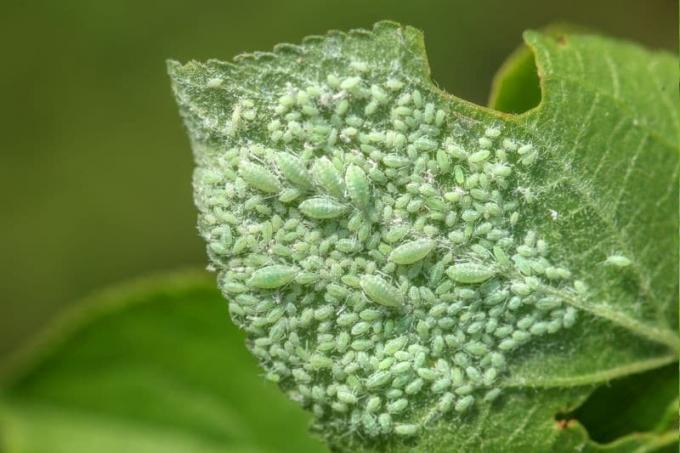
Currants (Ribes) are considered to be resistant to diseases. Nevertheless, leaf diseases can occur on currants, which you should know and distinguish from one another.
In a nutshell
- dangerous and harmless leaf diseases possible
- Combat is always advisable
- without targeted measures, fatal outcome in rust fungus and nettle leaf rash
Table of Contents
- leaf fall disease
- damage picture
- combat
- nettle leafiness
- damage picture
- combat
- Currant Bladder Louse
- damage picture
- combat
- rust fungus
- damage picture
- combat
- Frequently Asked Question
leaf fall disease
Leaf fall disease (Drepanopeziza ribis) most commonly affects white currants (Ribes sativa) and red currants (Ribes rubrum). The black ones currant varieties (Ribes nigrum) are rarely affected. Frequently, this disorder is mistaken as well frizz disease called, although this is a different fungal infestation. In leaf fall disease, the fungus infects Drepanopeziza ribis the plants. It is not life-threatening for the affected specimens. In the worst case, it ensures extensive defoliation after harvest. Depending on the spread, the crop yields are hardly reduced. Nevertheless, the fungus should be combated, because the spores overwinter and the fungus infects the currants again the following year.
damage picture

- frequent occurrence after wet spring
- first yellowish dots on the upper side of the leaves in the lower part of the bush
- develop into brownish-black spots with a sharply defined border
- leaf edges yellowed later
- curled and curled leaves
- noticeably high leaf drop until complete defoliation after harvest
combat
- Cut off severely affected branches generously
- Remove diseased leaves from branches worth preserving
- Collect fallen leaves continuously
- spray with horsetail or garlic broth twice a week in warm weather to strengthen the plants
- alternatively: nettle- or use onion skin manure
nettle leafiness
Nettle foliation is a viral disease caused by currant gall mites (Cecidophyopsis ribis). They transmit the virus, which mainly affects black currant bushes and less so the yellow and red fruit bushes. The “Baldwin” and “Wellington” varieties are known to be particularly sensitive to this virus attack. Young plants and cuttings are most at risk. If this leaf disease is not combated on the currant, there is a risk of serious harvest losses of 25 percent to 100 percent due to lack of fertilization. Plants can die after prolonged infestation. Therefore, this disease should be treated urgently.
damage picture

- Buds typically lose smaller and oval shape
- globular swollen blackcurrant buds
- loose, pointed buds of white and red currant
- usually only three-lobed growth of new leaves
- deep leaf incisions
- affected leaves are significantly darker than healthy ones
- irrigation of the flowering plants; increasingly reduced flowering
- Occurs in flowers from February/March and June; from May on leaves
combat
- Remove affected shoots if infested lightly
- If the infestation is severe, cut back the shrub to a few healthy shoots
- Spray with tansy tea daily for a two-week period to strengthen the plants
- use sulphur-containing preparations
Tip: The currant gall mite is also in the buds in winter. That's why you should consistently snap off these shoots in the fall. This can significantly reduce the extent of the infestation.
Currant Bladder Louse
This is not an official leaf disease on currants because it only spreads as a result of pest infestation Currant Bladder Lice (Cryptomyzus ribis) arises. Nevertheless, it should not be missing here, since the tiny parasites are usually only recognized after leaf abnormalities and are therefore mistaken for a leaf disease. This louse is classified as a mild pest that does not pose a major threat. An impairment of growth is not to be expected. Control of the louse is therefore usually not necessary. However, this can be useful to contain the infestation, especially if other herbaceous plants in the vicinity could also be infested.
damage picture

- visible from spring
- initially yellow to brown changing discoloration on the undersides of the leaves
- gall/blister-like growths on the leaf blades of new leaves (there are lice inside)
- mostly reddish, reddish-brown in color; rarely yellowish
combat
- Remove affected and infested parts of the plant
- use natural predators, such as ladybug and lacewings
- alternatively: spray dripping wet with soapy water three times a week
Tip: The soapy water works best if you prepare it like this: Dissolve 50 grams of soft or curd soap in one liter of warm water and add a dash of spirit.
rust fungus
Rust fungus (Cronartium ribicola) is a fungal disease also known as column grate is titled. After overwintering, the pathogens settle on five-needle pines from the area currant bushes in spring about. As a rule, only black currants are affected. The leaf disease is dangerous and needs to be combated quickly. The fungal spores are not only life-threatening for the bushes, but also a health hazard for humans and animals.
damage picture

- yellow-orange spore deposits on the undersides of the leaves from around June
- from July/August columnar spore formations; so-called teleutospores
- Color change to orange-red at higher humidity; brown-grey in dry humidity
- from autumn frequent pustule formation on leaves
- with increasing infestation increased leaf drop to baldness
- growth disorders
- without controlling plant death
combat
- immediately remove all affected leaves and dispose of at a safe distance
- Cut off severely affected branches completely
- shorten all remaining shoot tips slightly (stimulates growth)
- Collect and dispose of fallen leaves
Frequently Asked Question
Most leaf diseases are caused by fungi. Avoid a shady location when planting, thin out the shrubs regularly and make sure that you plant at a sufficiently large distance from your neighbors. You can prevent the currant bladder lice by using less nitrogen and fertilizing with compost once or twice a year. You can hardly prevent rust fungus, unless you want to remove pine trees at a distance of 100 meters.
Not at all, because the "real" curling disease does not affect currants, only almond, peach and nectarine trees. The name is mistakenly associated with leaf fall disease due to leaf curling. However, it is a different fungus, the Taphrina deformans. You can find out how to recognize the leaf fall disease in the article.
Not necessarily. Leaf fall disease can be behind this, but also a lack of water. The difference, which is quickly apparent, is that the leaves turn completely yellow if the drought is too high, while only yellow spots appear due to leaf fall disease.



